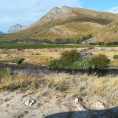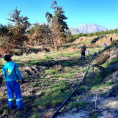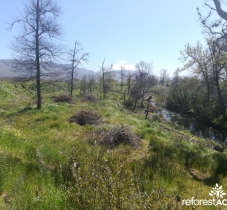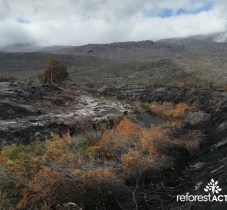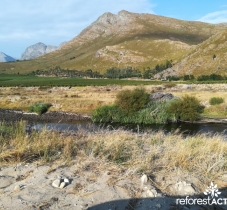Project description
In South Africa, Hennessy, Reforest'Action and its local partners are restoring an endemic forest ecosystem by replacing invasive plants with local species.
Overview of the project
Number of trees planted: 200 000 over two years
Species planted : Cape ash, Stinky white wood, Tree fuschia, Wild Fishing, Assegai, Olienhout, Cape beech, Cape yellow wood, Syzygium guineense, White karree, Karroo thorn, Wild plum, Harde Peer
Project type: reforestation of the banks of a river
Planting period: between February and May
Context of the project
By reforesting the banks of the Breede River in the Cape Region, Hennessy supports local communities and raises awareness of the benefits of reforestation.
In the heart of the Western Cape, along the Breede River, the fight against the invasion of exotic plant species is a major issue for the preservation of biodiversity and water. The invasion of exotic plants is indeed a national threat that jeopardizes the stability of South African ecosystems by negatively impacting water resources, promoting fires and competing with local vegetation. The original forest cover of the West of the Breede River, composed notably of endemic trees such as the Breede River Yellow Wood, the wild olive tree, or the wild almond tree, has today practically disappeared. In this context, Reforest'Action is partnering with the Western Cape Government and Breedekloolf Wine and Tourism. The objective: to restore the strength and diversity of this landscape to its former strength and diversity by fighting against exotic vegetation and replanting 100,000 trees and shrubs of 36 different endemic species.
The challenge of the project is to enable local farmers and wine producers to fight against the invasion of exotic vegetation on their land. The project will thus make it possible to recreate a forest cover composed of endemic species that once populated the systems to be restored, and which had disappeared from the landscape due to increased competition from exotic vegetation. The reintroduction of these endemic trees and shrubs, such as the African wild olive, Cape silver oak and African boxwood, will provide the level of competition against exotic plants necessary to combat future invasions, and will restore functional ecological diversity around the Breede River.
Actions in the field
2020-2021 season and 2021-2022 season
A total of 81,895 trees were planted between June and December 2021 on an area of 15.6 ha, and 118,105 between July and October 2022 on an area of 23.4 ha.
The project involves the active restoration of the Breede riverbank by reforestation through a 2-phase control of invasive alien species:
- Elimination of the spread of alien species (mechanical removal).
- Replanting cleared sites with 36 identified native plants, including wild olive, wild almond and Cape silver oak (now almost extinct) to prevent the re-establishment of competitive alien species.
The endemic species intended to repopulate and enrich the Breede riverbank ecosystem were first reconstituted in nurseries (local species banks) and then introduced according to the specific requirements of each species, mainly during the rainy season. During these two seasons of work, the seedlings were irrigated once a week in the dry season, via an underground aquifer containing a concentration of nutrients and minerals too high for human consumption but suitable for plants. This water is owned by each farmer and is usually dedicated to agriculture only. It is therefore their responsibility to determine how much of it is used for watering the restored ecosystem. In order to preserve the survival of the seedlings, effective firebreaks and irrigation systems were deployed due to a major fire hazard from October to February.
Benefits of the project
The project is already having a major impact on the surrounding communities. 40 local people trained by the project leader are working on setting up the nurseries (collecting, sorting, germinating and propagating seeds), maintaining them, preparing the planting sites, planting and monitoring, many receiving their only source of income. Very involved in the preservation of their environment, they provide the other members of the project with a detailed technical knowledge of their environment, particularly in the choice of tree species. 30 landowners will benefit from the project's impacts on their land in the longer term. As Ryno Piennar, conservation manager at Breedekloolf Wine and Tourism, explains, their outlook is changing: "One of them, who in the past had cut down trees, is now participating in the project and is extremely concerned about the future of the trees we are planting".
News from the field
The reforestation of the Breede and Berg river banks continues!Located along the Breede and Berg rivers in South Africa, the reforestation project supported by Ref
The project, based on the restoration of an endangered ecosystem, seeks to slow down the invasion of exotic woody species on several dozen private plots and to int

